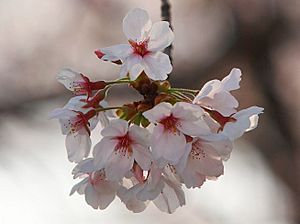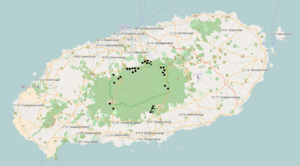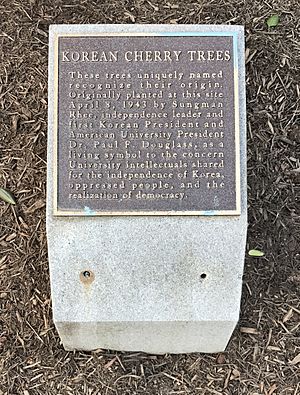Prunus × nudiflora facts for kids
Quick facts for kids Prunus × nudiflora |
|
|---|---|
 |
|
| Scientific classification | |
| Genus: |
Prunus
|
| Species: |
× nudiflora
|
| Synonyms | |
|
|
The Prunus × nudiflora is a special kind of cherry tree. It's often called the king cherry (왕벚 wangbeot). This beautiful tree comes from Jeju Island in Korea.
It's important to know that the king cherry is different from the Yoshino cherry tree from Japan. The king cherry is a very rare plant. It is even listed as an endangered species, meaning it's at risk of disappearing.
As of 2017, only 194 king cherry trees were found. They were growing around Mt. Halla on Jeju Island. For a long time, people thought a French missionary named Emile Taquet discovered the king cherry. But it turns out he found a different type of cherry tree.
There have been many discussions about where king cherry and Yoshino cherry trees first came from. Scientists believe both are "hybrids." This means they are a mix of two different parent trees. In 2007, a study showed that king cherry and Yoshino cherry are indeed different species.
However, some news in South Korea still says they are the same. Many cherry blossom festivals in Korea, like those in Yeouido and Jinhae, still feature Japanese Yoshino cherry trees.
Contents
What's in a Name?
In 1901, the Yoshino cherry got its scientific name, Prunus yedoensis. It was named by Jinzō Matsumura after its origin, Yedo (now Tokyo). In the early 1900s, people thought the king cherry was the same as the Yoshino cherry. So, it was also called Prunus yedoensis.
Later, in 1916, a scientist named Ernest Henry Wilson suggested that the Yoshino cherry was a mix of two other trees. Because of this, the Yoshino cherry started to be called Prunus × yedoensis. But the king cherry kept the old name, Prunus yedoensis.
In 2016, scientists proposed a new name for the king cherry: Cerasus × nudiflora. This happened after studies showed it was a hybrid. They also found it was genetically different from Prunus × yedoensis.
The Korean name wangbeonnamu (왕벚나무) means "king cherry tree." It was created in 1963. Before that, it was called sakuranamu (사쿠라나무), meaning "sakura," or teolbeonnamu (털벚나무), meaning "hairy cherry." The name wangbeotkkot means "king cherry blossom."
The Korean names wangbeonnamu or wangbeotkkot don't usually tell the difference between king cherry and Yoshino cherry. This is because people often thought they were the same. If they need to be specific, Yoshino cherry is called someiyosino (소메이요시노). This is a Korean way of saying its Japanese name.
How to Spot a King Cherry
King cherry trees are very rare in nature. In 1908, a single tree was found on Mt. Halla by Taquet. But another scientist, Koidzumi, said it was a different species. In 1932, Koidzumi found another single tree on the south side of Mt. Halla.
In 1962, the first Korean team to survey plants found three king cherry trees. The next year, they found three more. In 1998, 33 king cherry trees were found around Mt. Halla.
From 2015 to 2016, a research center looked for king cherry trees on Mt. Halla. They found 194 trees in 173 different spots! These trees grow at different heights, from 165 meters to 853 meters up the mountain. They can be 5 to 19 meters tall and 15 to 265 years old.
King cherry trees look a lot like Yoshino cherry trees. But there are small differences. In 1933, a scientist named Yo Takenaka noticed that king cherry trees have fewer hairs on their calyx (the green parts under the flower petals) and on the underside of their leaves. Their flower stems (peduncles) are also shorter.
In 1998, Chan-soo Kim studied many features of the flowers, leaves, fruits, and seeds. Most parts of the king cherry were smaller than those of the Yoshino cherry. The biggest difference is the shape of the calyx tube. In Yoshino cherry, it's cup-shaped. In king cherry, it's wedge-shaped. Also, Yoshino cherry flowers grow in clusters called corymbs, while king cherry flowers grow in umbels.
A Look Back in Time
- In 1908, a French missionary named Taquet found a native cherry tree on Jeju Island. In 1912, a German botanist, Koehne, named it Prunus yedoensis var. nudiflora. He thought it was a different type of Yoshino cherry. For a long time, people mistakenly thought Yoshino cherry grew naturally on Jeju Island because of this.
- In 1916, Ernest Henry Wilson looked at a king cherry sample. He wasn't sure about its origin. He felt more research was needed to find out where P. yedoensis truly came from.
- In 1932, Koidzumi found that both the cherry Taquet found and what is now known as king cherry grew naturally on Jeju Island. He said Yoshino cherry came from Jeju Island. Koidzumi also identified Taquet's discovery as a separate species, naming it Prunus nudiflora.
- In 1933, Takenaka visited Jeju Island. He saw the tree Koidzumi found. It grew wild and had differences from P. yedoensis. He concluded it couldn't be the same.
- In 1962, Takenaka's studies showed that Yoshino cherry likely did not come from Korea.
- In 2005, scientists used DNA to compare king cherry and Yoshino cherry. They found that the two trees are clearly different genetically.
- In 2007, another study confirmed that king cherry is native to Korea. It is also different enough from Yoshino cherry to be its own species. This study also showed that the cherry trees in Washington, D.C., given by Japan in 1912, are different from king cherry trees.
- In 2016, scientists used more DNA analysis. They again found that king cherry and Yoshino cherry are distinct. They also found that two old cherry trees in Daegu, thought to be king cherry from Jeju, were likely Yoshino cherry.
- In 2017, scientists used more DNA tests to tell the two groups apart. This study also showed that three "Korean cherry trees" planted at American University in 1943 were actually Yoshino cherry, not king cherry. Former South Korean president Syngman Rhee had planted them.
Family Tree Secrets
Scientists have been trying to figure out the "parents" of the king cherry. This means which two other cherry species combined to create it.
- In 1963, Takenaka thought king cherry might be a mix of Prunus subhirtella var. pendula form ascendens (Edo higan) and Prunus quelpartensis Nakai (Tanna-yamazakura).
- In 2014, scientists found strong evidence that king cherry is a hybrid. They believe the "mother" tree was Prunus spachiana form ascendens (Edo higan). The "father" tree was likely from a group including Prunus serrulata (Yamazakura) or Prunus sargentii (Oyamazakura).
- In 2018, a study looked at the king cherry's full genetic code. It confirmed that king cherry is an F1 hybrid. This means it's the first generation mix of its parents. The "mother" was P. pendula f. ascendens, and the "father" was P. jamasakura. This study clearly showed it's different from Yoshino cherry.
- In 2019, more studies suggested that king cherry came from several different mixes. The "mother" was P. spachiana f. ascendens. The "father" was most likely P. serrulata var. spontanea or P. serrulata var. quelpaertensis.
Growing King Cherry Trees
As of 2017, most cherry trees in South Korea are Yoshino cherry trees. Many came from Japan or were grown from trees planted during the Japanese colonial period. People in Korea want to replace these with native king cherry trees. So, they are working hard to grow more of the best king cherry varieties.
In 1996, a research institute planted 40 king cherry trees. These trees were grown artificially using a special method called tissue culturing. They bloomed for the first time in 2003.
Since 2000, the Warm-Temperate and Subtropical Forest Research Center has created a large area to protect king cherry trees. It's about 90,000 square meters. They are now growing 3,000 king cherry trees there.
In April 2017, the center announced even bigger plans. They have developed a 100,000 square meter farm for king cherry trees. They planted 4,150 young trees, aged four to five years old. The center plans to make this area even bigger, up to 250,000 square meters by 2022. Their goal is to grow a total of 20,000 king cherry trees!
Special Protected Areas
Places where king cherry trees grow naturally are protected. They are called "Natural Monuments." There are three main Natural Monuments for king cherry trees:
- Natural Monument No. 156 – Jeju Sinrye-ri King Cherry habitat. It was protected in 1964. 33°21′40″N 126°35′49″E / 33.361222°N 126.597034°E
- Natural Monument No. 159 – Jeju Bonggae-dong King Cherry habitat. Also protected in 1964. There are two king cherry trees here. 33°28′06″N 126°35′56″E / 33.468198°N 126.598824°E
- Natural Monument No. 173 - Haenam Daedunsan king cherry habitat. Protected in 1966. This area has two king cherry trees. 34°29′30″N 126°36′53″E / 34.491537°N 126.614690°E
- Jeju Province Monument No. 51 - Jeju Gwaneumsa King Cherry habitat. Protected in 1999. 33°25′26″N 126°33′30″E / 33.423817°N 126.558330°E



